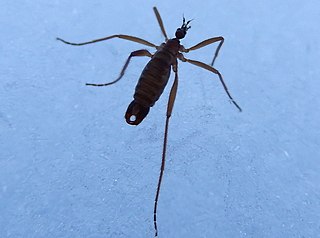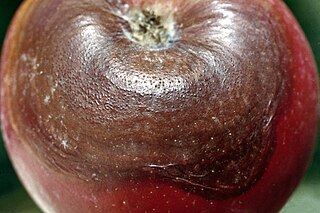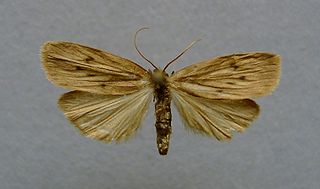
Chamaecyparis obtusa is a species of cypress native to central Japan in East Asia, and widely cultivated in the temperate northern hemisphere for its high quality timber and ornamental qualities, with many cultivars commercially available.

Banksia obtusa, commonly known as shining honeypot, is a species of shrub that is endemic to the south-west of Western Australia. It has underground stems, linear pinnatifid leaves with triangular lobes on each side, cream-coloured to yellow flowers in heads of up to seventy, surrounded by dark reddish bracts and egg-shaped follicles.

Chionea is a genus of wingless limoniid crane flies. It consists of two subgenera, the holarctic Chionea and palaearctic Sphaeconophilus. About 40 species are currently recognized in the northern hemisphere, but there are probably several undescribed species. They are commonly called snow flies.

Botryosphaeria obtusa is a plant pathogen that causes frogeye leaf spot, black rot and cankers on many plant species. On the leaf it is referred to as frogeye leaf spot; this phase typically affects tree and shrubs. In fruit such as the apple, cranberry and quince, it is referred to as black rot, and in twigs and trunks it causes cankers.

Plumeria obtusa, the Singapore graveyard flower, is a species of the genus Plumeria (Apocynaceae). It is native to the West Indies, southern Mexico, Belize, Guatemala, and Florida. but widely cultivated for its ornamental and fragrant flowers around the world, where suitably warm climate exists. It is reportedly naturalized in China.

Pelosia obtusa, the small dotted footman, is a moth of the family Erebidae. The species was first described by Gottlieb August Wilhelm Herrich-Schäffer in 1847. It is found from central Europe through Asia to the Pacific Ocean.

Hakea obtusa is a shrub in the family Proteaceae and is endemic to an area along the south coast in the Goldfields-Esperance regions of Western Australia. It has white and pink fragrant flowers in autumn and spring.
Chionea scita is a species of crane fly in the family Limoniidae. C. scita is known as a type of snow crane fly because it is commonly seen walking on piles of snow during the winter months. These flies are also often observed in caves and heavily wooded areas. C. scita flies are small, hairy, wingless, and somewhat spider-like in appearance, unlike other flies.
Chionea alexandriana is a species of limoniid crane fly in the family Limoniidae.
Diplocheila obtusa is a species of ground beetle in the family Carabidae. It is found in North America.
Mozena obtusa is a species of leaf-footed bug in the family Coreidae. It is found in North America.

Clastoptera obtusa, the alder spittlebug, is a species of spittlebug in the family Clastopteridae. It is found in North America.
Marpissa obtusa is a species of jumping spider in the family Salticidae. It is found in the United States.
Supralathosea obtusa is a species of mossy sallow in the moth family Noctuidae.
Chionea albertensis is a species of limoniid crane fly in the family Limoniidae.
Chionea valga, the snow fly, is a species of limoniid crane fly in the family Limoniidae.
Oligia obtusa is a species of cutworm or dart moth in the family Noctuidae.
Chionea stoneana is a species of limoniid crane fly in the family Limoniidae.
Chionea carolus is a species of limoniid crane fly in the family Limoniidae.
Acmaeodera obtusa is a species of metallic wood-boring beetle in the family Buprestidae. It is found in North America.







